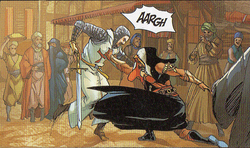The Egyptian Brotherhood of Assassins, also known as the Hidden Ones during its early years, was the Guild of Assassins located in Egypt. It was the oldest Assassin branch, having originally been founded by the Medjay Bayek and his wife, Aya, in 47 BCE.
History
Ptolemaic Egypt
Precursors
During the 2nd century BCE, a group that served as the precursors to the Assassin Brotherhood seemingly operated in Egypt, as the Rosetta Stone, issued in 196 BCE, contained sensitive information concerning the Assassins.[2]
Foundation as the Hidden Ones
- Aya: "When we assassinate, we assassinate only those who deserve it. The few sick souls who try to control us... but they will never know who we are. Cold, calculated poets of the kill."
- Bayek: "I am fine with this. I am not a father anymore. I am not a husband. I am not a Medjay. I am a Hidden One."
- —Bayek and Aya during the inception of their brotherhood, 47 BCE.[src]
In 49 BCE, members of the Order of the Ancients, a group that would later develop into the Templar Order, travelled to the Siwa Oasis in Egypt to discover more about an Isu vault hidden beneath the Temple of Amun. In doing so, they kidnapped the local protector, the Medjay Bayek, and his young son Khemu to push the Medjay for information. The altercation led to the death of his son, sending Bayek and his wife Aya on a quest for vengeance against the Ancients. After killing his first target Rudjek, Bayek returned to Siwa to kill the priest Medunamun, from whom he obtained an Apple of Eden.[3]
Aya was bound to her duties as protector to Queen Cleopatra, who was engaged in a civil war with her brother Ptolemy XIII, supported by the Ancients. During her absence, Bayek hunted the men responsible, forming a network of people opposing the Ancients and supporting Cleopatra. As Bayek took down most of the Order's network, his and Aya's attentions shifted to helping Cleopatra secure an alliance with Pompey the Great against Ptolemy to get support from the Roman Republic. When the Ancients had Pompey murdered, they helped her meet with Pompey's rival, general Julius Caesar, in Alexandria, which formed a successful alliance. The two later aided Cleopatra by unlocking the door to the tomb of Alexander the Great.[3]
However, this allowed the Ancients – who were manipulating Caesar and Cleopatra as well – to obtain Alexander's Staff of Eden, having taken the Apple of Eden from Cleopatra's follower Apollodorus the Sicilian. In 47 BCE, after Caesar and Cleopatra betrayed Bayek and Aya under the Ancients' influence, the two returned to Siwa to stop the Order's leader Flavius Metellus, finding only an opened vault. Bayek tracked Flavius down, exacting revenge for their son and reacquiring the Apple.[3]
Meanwhile, Aya had recruited the Roman Senators Marcus Junius Brutus and Gaius Cassius Longinus, enemies of Caesar, to their cause, determined to leave for Rome to combat the Ancients there. Before leaving, Bayek and Aya named their new brotherhood the Hidden Ones, laying out the foundation of the Creed and their customs. They each established bureaus in Memphis and Rome.[3]
Assassination of Cleopatra
On 12 August 30 BCE, seventeen years after the formation of the Hidden Ones, and thirteen years after Aya, who by then had adopted the name Amunet, decided to spare Cleopatra's life after killing Caesar,[3] the Assassin killed the Egyptian Queen in Alexandria, by using a poisonous asp.[4]
Middle Ages
Aiding the Mamluks

The Egyptian Assassin killing a Templar knight
In the early 13th century, the Egyptian Assassins acquired the Scepter of Aset from a merchant, who had purchased it from Italian fishermen that had discovered it after it was lost in a Roman shipwreck during Antiquity. In 1250, after the Mamluks rose up against the reigning Ayyubid dynasty, the Brotherhood, who had formed an alliance with the Mamluks, tasked an unidentified Egyptian Assassin with delivering the Scepter to them. However, while on his way to deliver the artifact in Cairo, the Assassin was attacked by Templar knights.[5]
Despite being injured, the Assassin managed to kill the Templar knights and successfully delivered the Scepter of Aset to the Mamluks, allowing them to succeed in their slave revolt against the rule of their Ayyubid overlords and effectively laying the foundation for the Bahri dynasty.[5]
In 1257, Darim Ibn-La'Ahad, son of the Mentor of the Levantine Brotherhood, Altaïr Ibn-La'Ahad, moved to Alexandria after the Levantine Assassins were disbanded.[6] Darim joined the widow of his deceased brother and her children,[7] which led to their bloodline integrating into the Egyptian Assassins.[6] Darim also notably gave an Apple of Eden to the first Sultan of the Bahri dynasty, further strengthening his power.[5]
Search for the Scepter of Aset

Numa fighting Templars in Karnak
In 1340, after the Scepter of Aset had remained in the possession of the Mamluks Sultans for nearly a century, the Egyptian Templars stole it from the Sultan Al-Nasir Muhammad and the Assassins entrusted Numa Al'Khamsin, better known as "El Cakr", and his apprentice Ali Al-Ghraib with the task to find the artifact. One year later, Numa and Ali managed to track down the Templars to their hideout in Karnak.[8]
Arriving at night near the Temple of Amun, the two walked across a village, when Ali noticed a man wearing a dagger with the Templar cross on it. After telling this to his master, Ali started a fire as a distraction, so that Numa was able to look for the Scepter of Aset unnoticed.[8]
However, the distraction was not effective and Numa became surrounded by Templars. While the Assassin engaged in battle with his enemies, Ali stole the Scepter from the Templars. Numa and his apprentice then fled from Karnak, taking the artifact with them.[8]
Losing the artifact
Two days later, El Cakr arrived at the Sultan’s palace in Cairo. Although the Sultan’s Emirs expected Numa to hand over the artifact, the Assassin did not trust the Emirs and told them the artifact would remain in Assassin hands until a dignified successor to the throne would be presented. Interpreting Numa’s words as an insult, the Emirs locked him up in a prison cell.[8]
While in the cell, Numa met a woman named Leila, a Templar agent and former servant of Al-Nasir Muhammad, whom she had seduced and killed. After convincing Numa that she was not a true believer of the Templar cause and had merely used them in order to kill the sultan, the two escaped and headed for a safe house that Leila had arranged in the city in order to lay low after the murder of the Sultan. There, she seduced Numa into a sexual encounter.[9]
While Numa was in prison, Ali was captured by the Templars at the Temple of Edfu and was tortured by them, which resulted in them breaking his wrist. Eventually he cracked, agreeing to help them eliminate his master in exchange for his life.[9]
After Numa arrived at Edfu Temple and noticed Ali's bandaged wrist, the Templars surrounded him and Ali. One of them came forward and explained that the Scepter was no longer the only priority of the Order, revealing that Numa was such a nuisance that his death was now a new priority. Lowering her hood, the Templar revealed herself to be Leila and she told El Cakr that she felt no hate towards him but had to follow orders before she began dueling with him. Perfectly trained, Leila revealed that everything she had told Numa about her commitment to the Templars was a lie before putting a dagger into his heart, instantly killing Numa before the eyes of his distraught apprentice. However, keeping her promise to spare Ali, Leila let the shaken Assassin apprentice go.[9]
However, Ali, even though he had betrayed his master, was still loyal to the Brotherhood and threw the Scepter in a well near Edfu with the intent to contact the Brotherhood and come back later, but died a few weeks later of food poisoning, from eating tainted meat. Leila, who had discovered Ali's ruse, managed to briefly find the artifact in the well, only to suffer a head injury while climbing up with it, becoming amnesiac and, after being rescued and tended by passing Bedouins, died nine months later from internal bleeding while giving birth to the child she had conceived with El Cakr during their night in the safe house. As a result, the scepter remained hidden to all.[9]
Renaissance
By 1511, the Egyptian Assassins were under the leadership of their Mentor Iskender, a descendant of Altaïr Ibn-La'Ahad. He was captured to be executed that year, but was saved by Ottoman Assassins sent from Constantinople by the Mentor of the Italian Brotherhood, Ezio Auditore da Firenze.[6]
Ottoman Egypt
By 1794, the Egyptian Assassins were led by an individual who was known as Al Mualim, who was based in Cairo. Arno Dorian sent one of his fellow Parisian Assassins to the city with the Apple of Eden he had taken from the Head of Saint Denis to keep it safe.[10]
Members
Ptolemaic Egypt
Mamluk Sultanate
- Ali Al-Ghraib
- Assassin Elder
- Darim Ibn-La'Ahad (Levantine Assassins)
- Unidentified Assassin
- Iskender
- Numa Al'Khamsin
Ottoman Empire
Allies
Ptolemaic Egypt
- Apollodorus the Sicilian
- Cleopatra (betrayed)
References
- ↑ Assassin's Creed: The Essential Guide
- ↑ Assassin's Creed: Unity
- ↑ 3.0 3.1 3.2 3.3 3.4 Assassin's Creed: Origins
- ↑ Assassin's Creed II
- ↑ 5.0 5.1 5.2 Assassin's Creed 4: Hawk
- ↑ 6.0 6.1 6.2 Assassin's Creed: Revelations
- ↑ Assassin's Creed: The Secret Crusade
- ↑ 8.0 8.1 8.2 8.3 Assassin's Creed 5: El Cakr
- ↑ 9.0 9.1 9.2 9.3 Assassin's Creed 6: Leila
- ↑ Assassin's Creed: Unity - Dead Kings
| ||||||||||||||||||||||||||||||||||||||||


